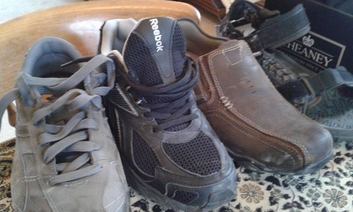
Lecturer, University of Portsmouth, UK
Professor Victoria Robinson,
Director, Centre for Women’s Studies at University of York, UK
Dr. Lisa Farndon,
Podiatric Development Facilitator, Sheffield Teaching Hospitals, UK
'Stiletto heels, they can put you in another world. It's how you walk and how you carry yourself.’ (Elizabeth, 80s)
Our work builds directly on a previous UK ESRC funded project, ‘If the Shoe Fits, Footwear, Identification and Transition’ involving one of the research team (Vicki Robinson), which showed the centrality of footwear to individuals' sense of their embodied identity. This more recent project involved interviews with podiatrists, shoe fitters and their patients; with several of the patient participants taking part in follow-up interviews and completing ‘shoe diaries’ to chart their everyday, lived experiences of choosing and wearing shoes. Some of the patients involved in the study had complex, long-term health conditions and were accessing Podiatry Services alongside receiving support from other services as part of managing conditions such as cancer and diabetes. We noted that these participants were often engaged in complex processes of managing their health, well-being and identities, with shoe choice playing a role in this. For these participants, shoes occupied a dual position as both an aid or impediment to mobility and health yet also a key part of dress and appearance, with shoes often playing a role in how identity as ‘sick’ or ‘well’ was portrayed to others and at times acting as ‘a symbol displayed by owners to reinforce their self-image’ (Gillath et al., 2012: 424).
Several of the participants with more complex health needs prioritised physical comfort over fashion and described a discrepancy between the types of shoes they would like to wear and the types of shoes that they actually wore, as illustrated by Frank, a diabetic in his 50s:
‘I have to think about comfort more than anything else. No matter what they look like, even though I don't like them, I still get them if they fit okay’
‘It [my shoe choice] says ‘he's disabled’. It says ‘he's disabled and that's what he is’. You see a disabled person but I'm more than that. I'm a person in my own right with thoughts, feelings, ability, strengths, values... I've got intelligence but if you look at my shoes, on looking at my feet it looks like I don't care, it looks like it devalues me as a person’ (Nigel, 40s)
Other participants with complex health needs were more resistant towards making changes to their shoe choices, in part because physical comfort was not always their priority. The emotional, psychological and social aspects of ‘comfort’ were also mentioned, echoing Seferin and Van der Linden’s (2012) point that distinctions can be drawn between physical comfort and psychological comfort:
‘As long as I feel comfortable, not only just with my feet but inside as well, that's important’ (Megan)
‘…with the shoes I just think, no, it's the only thing I feel I can say no or rebel against if I'm honest… whereas everything else I just have to go with what they [medical professionals] say because otherwise I wouldn't be here. Where my shoes are concerned that is the only bit of control I've got’
‘…with everything that's wrong with me on the inside, the last thing I want is a pair of big shoes that just look so ugly and unattractive that people think ‘oh she's got something wrong with her feet as well’… I had a stroke a couple of years ago and nobody would know. And I don't use walking aids or anything because I just flatly refuse anything like that, so the last thing I want is my shoes to stand out. I don't define myself by my medical condition… I'm me and I just like to carry on as I always have’
|
These findings suggest that consideration of some of the ways in which patients’ foot conditions and shoe requirements intersect with long-term, chronic and complex health conditions is extremely important. Clearly, recognising the links between people’s shoes and wider sense of who they are is crucial if podiatrists are to help patients to make sustainable changes to their footwear habits that do not simultaneously have a negative impact on their sense of self and well-being. As part of this, an understanding of the ways in which shoes may work towards constructing or resisting particular types of embodied identity is critical.
* This collaborative project was funded through the University of Sheffield's Impact, Innovation and Knowledge Exchange (IIKE) scheme, with a contribution of time, resources and expertise from Sheffield Podiatry Services, Sheffield Teaching Hospitals, UK. The findings of the study have been used to develop an online footwear ‘toolkit’ to assist foot health professionals as part of their training and to inform and develop practice. This website and associated tools and publications have been designed to highlight and explore potential barriers to changing footwear and support practitioners to engage in dialogue with patients to address these barriers in ways that take patients’ preferences, motivations and values into consideration. The full footwear toolkit is available at http://www.sheffield.ac.uk/podiatrytoolkit
References
BRANTHWAITE, H., CHOCKALINGAM, N., GROGAN, S., et al. 2013. Footwear choices made by young women and their potential impact on foot health. Journal of Health Psychology, 18, 1422-1431.
FARNDON, L., ROBINSON, V., NICHOLLS, E, and VERNON, W. 2016. If the shoe fits: development of an on-line tool to aid practitioner/patient discussions about ‘healthy footwear’. Journal of Foot and Ankle Research, 9(17), pp. 1-6.
GILLATH, O., BAHNS, A. J., GE, F., et al. 2012. Shoes as a source of first impressions. Journal of Research in Personality, 46, 423-430.
GOODACRE, L. J. & CANDY, F. J. 2011. ‘If I didn’t have RA I wouldn’t give them house room’: the relationship between RA, footwear and clothing choices. Rheumatology, 50, 513-517.
HARRISON, S., COCHRANE, L., ABBOUD, R., et al. 2007. Do patients with diabetes wear shoes of the correct size? Int J Clin Pract, 61, 1900-4.
HOCKEY, J., DILLEY, R., ROBINSON, V., et al. 2013. Worn Shoes: Identity, Memory and Footwear. Sociological Research Online, 18, 20.
PARNÉS, A. 2007. If the shoe fits…footwear and patients with diabetes. International Journal of Clinical Practice, 61, 1788-1790.
POND, M. 1985. Shoes Never Lie, New York, Berkley Publishing Group.
SEFERIN, M. & VAN DER LINDEN, J. 2012. Protection or pleasure: female footwear. Work: A Journal of Prevention, Assessment and Rehabilitation, 41, 290-294.
SILVESTER, R. N., WILLIAMS, A. E., DALBETH, N., et al. 2011. Choosing shoes: A preliminary study into the challenges facing clinicians in assessing footwear for rheumatoid arthritis patients. Journal of Foot and Ankle Research, 4, O43.
VERNON, W., BORTHWICK, A. & WALKER, J. 2011. The management of foot problems in the older person through podiatry services. Reviews in Clinical Gerontology, 21, 331-339.

 RSS Feed
RSS Feed
